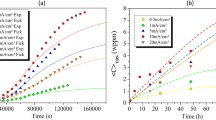Abstract
A theoretical and experimental study was conducted to determine the combined effects on interstitial diffusion in metals of gradients in interstitial concentration, in solvent composition, in stress, and in temperature. The theory consolidates relationships, some of which have been previously published. It is based on macroscopic irreversible thermodynamics, and is applicable to anisotropic or Isotropic materials. Experiments were conducted and literature analyzed to determine the numerical quantities required to predict the change in hydrogen distribution with time for pure and alloy titanium, where the solvent gradient, stress gradient, and temperature gradient are constant with time. The diffusion driving forces for solute gradient, solvent gradient, and stress gradient are related to the effect of each factor on hydrogen activity. In addition, the material property which determines the diffusion driving force of a stress gradient for anisotropic material is a matter tensor analogous to the scalar partial molal volume used for isotropic material. The experiments, conducted with commercially pure titanium and titanium alloy, 6A1-4V, consist of measuring the effect of alloy additions and stress on the hydrogen activity in solid solution and the dilatation effect of hydrogen. Stress states tested were tension, compression, and torsion. The measurements were made by exposing titanium and the alloy to hydrogen at temperatures from 600° to 800° C, and measuring the equilibrium hydrogen gas pressure at various solid solution hydrogen contents. Both materials were tested with and without stress. Tension decreased the activity, compression increased it, and torsion had no effect. This is consistent with the stress effect theory of Li, Oriani, and Darken. The stress effect corresponds to an apparent partial molal volume of 1.7 to 2.2 cm3/mol, depending on the alloy and hydrogen content.
Similar content being viewed by others
References
L. S. Darken:AIME Trans., 1949, vol. 180, pp. 430–38.
P. G. Shewmon:Diffusion in Solids, pp. 23–25, McGraw-Hill, New York 1963.
P. G. Shewmon:AIME Tram., 1949, vol, 212, pp. 642–47.
S. R. DeGroot:Thermodynamics of Irreversible Processes, pp. 1–12, 98, Interscience Publishers, New York, 1952.
S. R. DeGroot and P. Mazur:Non-Equilibrium Thermodynamics, p 39, North Holland Publishing Co., Amsterdam, 1962.
K. G. Denbigh:The Thermodynamics of the Steady State, Methuen, London, 1950.
J. C. Li, R. A. Oriani, and L. S. Darken:Z. Physik. Chem., 1966, vol. 49, pp. 271–90.
H. B. Fallen:Thermodynamics, p. 219, John Wiley and Sons, Inc., New York, 1960.
L. S. Darken and R. W. Gurry:Physical Chemistry of Metals, pp. 75–78, McGraw-Hill, New York, 1953.
J. Nye:Physical Properties of Crystals, pp. 22,106, Clarendon Press, Fair Lawn, New Jersey, 1957.
R. Aris:Vectors, Tensors, and the Basic Equations of Fluid Mechanics, p. 246, Prentice-Hall, New York, 1962.
R. P. Marshall:Trans. AIME, 1965, vol, 233, pp. 1449–50.
A. D. McQuillan:Proc. Roy. Soc. (London), 1950, vol, 204, pp. 309–23.
A. D. McQuillan:J. Inst. Metals, 1951, vol. 79, pp. 73–88.
F. A. Besel: Master’s Thesis, College of Engineering, New York University, April 1961.
J. L. Waisman: Ph.D. Dissertation, UCLA, 1969.
R. A. Oriani: U. S. Steel Research Center, Monroeville, Pa. 15146. Private correspondence, Dec. 19,1968; Jan. 27,1969.
A. D. McQuillan and M. K. McQuillan:Titanium, Academic Press Inc., New York, 1956.
W. T. Lindsay, Jr.: Abstracts of Amer. Chem. Soc. Natl Meeting, Pittsburgh, March 1966.
H. A. Wriedt and R. A. Oriani: "Effect of Tensile and Compressive Elastic Stress on Equilibrium Hydrogen Solubility in a Solid", October 21,1969, Edgar C. Bain Laboratory for Fundamental Research, Monroeville, Pennsylvania.
R. J. Wasilewski and G. L. Kehl:Metallurgy, 1954, vol. 50, pp. 225–30.
R. J. Wasilewski and G. L. Kehl:J. Inst. Metals, 1954, vol. 83, pp. 94–104.
F. C. Wagner, E. J. Bucur, and M. A. Steinberg:Trans. ASM, 1956, vol.48, pp. 742–61.
D. Goold:J. Inst. Metals, 1960, vol. 88, pp. 444–48.
A. D. McQuillan, C. E. Ellis, H. Pessal, A. P. Bennett, J. Basterfield, and A. D. Wallbank: The Solution of Hydrogen in Body-centered Cubic Metals, Report from the University of Birmingham, 1964.
W. Beck, J. O. M. Bockris, J. McBreen, and L. Nanis:Proc. Roy. Soc. (London), Series A, 1966, vol. 290, pp. 220–35.
F. de Kazinczy:Jemkontorets Ann., 1955, vol, 139, pp. 885–92.
H. Margolin and H. Portisch:Trans. TMS-AIME, 1968, vol. 242, pp. 1901–13.
H. Margolin: New York University, New York, School of Engineering, Private Correspondence, Feb. 13, 1969.
R. P. Elliott:Constitution of Binary Alloys First Supplement, McGraw-Hill New York, 1965.
S. O. Kline and F. A. McClintock:Mech. Eng., 1953, vol. 75, pp. 3–8.
Author information
Authors and Affiliations
Additional information
An erratum to this article is available at http://dx.doi.org/10.1007/BF02645633.
Rights and permissions
About this article
Cite this article
Waisman, J.L., Sines, G. & Robinson, L.B. Diffusion of hydrogen in titanium alloys due to composition, temperature, and stress gradients. Metall Trans 4, 291–302 (1973). https://doi.org/10.1007/BF02649629
Received:
Published:
Issue Date:
DOI: https://doi.org/10.1007/BF02649629




